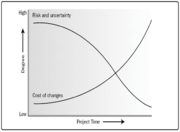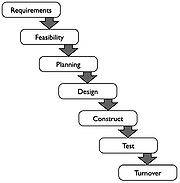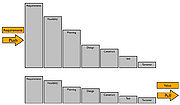Waterfall vs. Pull Processes
(→Waterfall Process) |
(→Waterfall Process) |
||
| Line 82: | Line 82: | ||
==Pros== | ==Pros== | ||
| − | + | Easy to use and understandable. | |
| − | + | The team leader is distributing the tasks to the team members - no further training and | |
| − | + | ||
| − | + | The agreement between project leader and customer on what will be delivered in the early stage of the project life cycle makes the planning more straightforward. | |
| − | + | Since the full scope of work is known at the beginning, the measurement of progress is easier. | |
| − | + | ||
| + | |||
| + | Easy to use and manage: Because the Waterfall model follows the same sequential pattern for each project, it is easy to use and understand. The team doesn’t need any prior knowledge or training before working on a Waterfall project. Waterfall is also a rigid model; each phase has specific deliverables and review, so it’s easy to manage and control. | ||
| + | |||
| + | Discipline is enforced: Every phase in Waterfall has a start and end point, and it’s easy to share progress with stakeholders and customers. By focusing on requirements and design before writing code, the team can reduce the risk of a missed deadline. | ||
| + | |||
| + | Requires a well documented approach: Waterfall requires documentation for every phase, resulting in better understanding of the logic behind the code and tests. It also leaves a paper trail for any future projects or if stakeholders need to see more detail about a certain phase. | ||
| + | |||
| + | |||
==Cons== | ==Cons== | ||
Revision as of 15:10, 26 February 2018
There are many different methodologies of project management, all of them are defined by different principles and processes. A traditional, sequential methodology, is the waterfall model. Within this model, the tasks of the project plan are sequenced and conducted in a linear way, one task must be completed before the next one begins - the process is smooth and continuous, like a waterfall. Therefore, this model is one of the simplest methods. However, the pull process-based methodologies are used to create the whole project plan more efficient and effective, it was created to eliminate confounding factors within the project and to avoid aimless work. Hence, the pull processes are used in the management style of Lean Project Management, typical pull processes can be find in the Scrum and Kanban methodologies. This article provides an introduction to the waterfall methodology, to understand the processes within a project plan in a better way. However, the article provides a comparison of the waterfall process (push process) and the pull process. Therefore, no other methodologies e.g. Scrum and Kanban are explained. For the comparison of the two different processes are pros and cons described and the relevance for the practical usage demonstrated.
Contents |
Importance for Project Management
A project is divided in several phases (except the single-phase project), and five project groups.
1. Initiating Process Group:Those processes performed to define a new project or a new phase of an existing project by obtaining authorization to start the project or phase.
2. Planning Process Group: Those processes required to establish the scope of the project, refine the objectives, and define the course of action required to attain the objectives that the project was undertaken to achieve.
3. Executing Process Group: Those processes performed to complete the work defined in the project management plan to satisfy the project specifications.
4. Monitoring and Controlling Process Group: Those processes required to track, review, and regulate the progress and performance of the project; identify any areas in which changes to the plan are required; and initiate the corresponding changes.
5. Closing Process Group: Those processes performed to finalize all activities across all Process Groups to formally close the project or phase.
The project manager has to combine those phases into a flow and take into account the product or service, his team and the customer. To establish a real customer value the project should set up a scope baseline control, build a communication plan to improve the information flow, asses stakeholder needs and get the commitment of the internal stakeholder. As a result, there are many factors which have to be intertwine to each other. Thus, project managers are inclined to overlook something at the beginning of the project and this is when project wastes start building. It is important to align with the customers to establish the customer value, but if the customer is deflect the project team members it will be end in scope creep. As an interim conclusion, the project planning has to consider a lot of things simultaneously, but it is also very important to ponder in which way and rate the steps are executed.
A project life cycle displays typically four characteristics:
1. The costs and staffing level starts at the beginning of the project low, increase when the work is carried out and decrease quickly when the project is going to close.
2. Not all projects describe a typical cost and staffing curve, they may require resources early in its life cycle and therefore higher expenditures.
3. A project starts with a high amount of risk and uncertainty and run low during the ongoing life cycle.
4. The influence to the final product/service starts on an high level with low costs. At the beginning of the cycle the vision can be adjust rapidly and economically, changes at the end of the project will cause high expenses.
With this description of the characteristics of a project life cycle, we can have a look to the different life cycles, which are designed for different purposes. The main difference of the waterfall model and the pull processes is the influence of the stakeholder and the degree of flexibility. Adaptive life cycles keep stakeholders in the loop and let them influence the project in a higher degree than a predictive life cycle (waterfall). Since, the project plan within a adaptive life cycle is more flexible the costs of changes are lower.
The importance to think about the way how to execute the project and how flexible and influenceable it should be is enormous. Therefore, the following chapters will provide some clarity about the choose of process styles.
Waterfall Process
The waterfall model (also known as predictive life cycle or fully plan-driven) is made of a waterfall process, which is defined by sequential relationships. A phase, consisting generally all five process groups, starts only when the previous phase is complete. This approach reduces uncertainty within the project life cycle, but it requests a high amount of tasks. As a result, this process is defined by a huge workload. In addition, the project scope, and the time and the cost required to deliver that scope, are determined at the beginning of the project life cycle. Therefore, the project is inflexible and changes are related to high costs. The waterfall model is preferred when the product or service to be delivered is well understood and the following processes describe the waterfall model.
Requirements
Firstly, the project team need an understanding of the project's function, purpose etc, the specifications of the input and output of the final product or service are studied and marked.
Feasibility In the feasibility phase, the target is about finding out all the potential problems. The problems should be evaluated and analyzed and considered for the decision making process.
Planning When the boundary conditions are clear and all parameters marked out, the project team can begin with the planning phase. In this phase all the next steps are described in detail, and are linked to each other. The team leader is pushing the future tasks to the team members.
Design The requirement specification is used to transfer the gathered date into a system design. At the end of this phase the members should know how the product looks like.
Construct
With the input of the last phase, the system design is implemented to the product - the product or service is constructed.
Test
After the construction, all the parts have to be tested, so that the customer does not face any trouble.
Turnover Once the testing is done, the product is released into the market or deployed in the customer environment. After the release it is possible to make modifications to the product/service/system.
With the waterfall model, the different sequences and the sequential relationship in mind, it is important to know that in this flow of processes, the tasks are pushed by the team leader to the project team members. Although it's resulting in a higher amount of workload, the tasks are handled step-by-step, even when the result is not used in the next phase anymore. This work method is attributed to the planning in the early stage of the project.
Pros
Easy to use and understandable. The team leader is distributing the tasks to the team members - no further training and
The agreement between project leader and customer on what will be delivered in the early stage of the project life cycle makes the planning more straightforward. Since the full scope of work is known at the beginning, the measurement of progress is easier.
Easy to use and manage: Because the Waterfall model follows the same sequential pattern for each project, it is easy to use and understand. The team doesn’t need any prior knowledge or training before working on a Waterfall project. Waterfall is also a rigid model; each phase has specific deliverables and review, so it’s easy to manage and control.
Discipline is enforced: Every phase in Waterfall has a start and end point, and it’s easy to share progress with stakeholders and customers. By focusing on requirements and design before writing code, the team can reduce the risk of a missed deadline.
Requires a well documented approach: Waterfall requires documentation for every phase, resulting in better understanding of the logic behind the code and tests. It also leaves a paper trail for any future projects or if stakeholders need to see more detail about a certain phase.
Cons
Here are some issues we have encountered using a pure Waterfall approach: One area which almost always falls short is the effectiveness of requirements. Gathering and documenting requirements in a way that is meaningful to a customer is often the most difficult part of software development, in my opinion. Customers are sometimes intimidated by details, and specific details, provided early in the project, are required with this approach. In addition, customers are not always able to visualize an application from a requirements document. Wireframes and mockups can help, but there’s no question that most end users have some difficulty putting these elements together with written requirements to arrive at a good picture of what they will be getting. Another potential drawback of pure Waterfall development is the possibility that the customer will be dissatisfied with their delivered software product. As all deliverables are based upon documented requirements, a customer may not see what will be delivered until it’s almost finished. By that time, changes can be difficult (and costly) to implement.
Pull Process
Overlapping
LEAN Overview - Define Value - Map Value Stream - Create Flow - Establish Pull - Pursuit Perfection
"Let the customer pull value from the project team" Not just the customer is "pulling"-> (Der nachfolgende Schritt gibt den Impuls wann es weiter geht)
Kanban + Scrum
By adding out of scope functionalities, you can expect that it will impact negatively your project triple constraint. If you make more work than required at a certain time, it will be pilled in waiting to be expedited to the next step. You should also avoid here to execute project management activities in a batch. Indeed if there is any product change request then you would end up with obsolescence and therefore waste.
The challenge here is to avoid delivering value before the customer request it. Also you should not provide to the customer more than the agreed initial scope. In manufacturing, we let the customer pulling the flow by means of a Kanban system. Kanban allows the implementation of a just-in-time system. It uses cards to signal the need for an item by triggering the movement, production, or supply of a unit.
Unlike a “push” system, where work is given to a person and put onto a massive “to-do” list, pull systems allow the person doing the work to pull in tasks as they are ready. This prevents people from feeling overloaded and forces teams to prioritize. This means that project managers and team members can focus on the right tasks at the right times while reducing wasted time or effort. Kanban control systems can significantly increase productivity and speed up task delivery.
The purpose of pull planning is to design a project-based production system in conformance with lean principles. Like all aspects of Last Planner, it is a collaborative approach that includes those who are directly responsible for supervising the work on the project. People mistake merely scheduling a phase of work from the end working backwards for the intent of pull planning. One of the keys to success in designing a production system based on lean principles is to get all of the work experts who are supervising the work, we call them last planners, to engage with each other to collaboratively work out a plan for the phase that includes the best of the alternatives available to them. Facilitating that conversation can be a challenge if you aren’t starting out with the right question. What question?
Pros
It supports the continuous flow of work
Work is done as a team
There is a clear indication of state of work
Work in progress is limited for each status
There is a lesser burden on individual backlog
It allows better planning and prioritization of work
It allows improved continuous delivery
Kanban system implements the pull model for continuous delivery by eliminating the waste and focusing on continuous improvement.
Cons
Waterfall vs. Pull
Summary pros cons. Workload image




